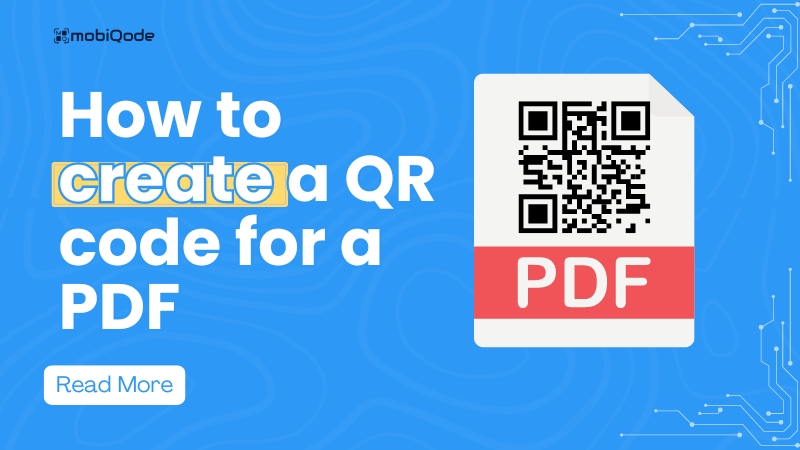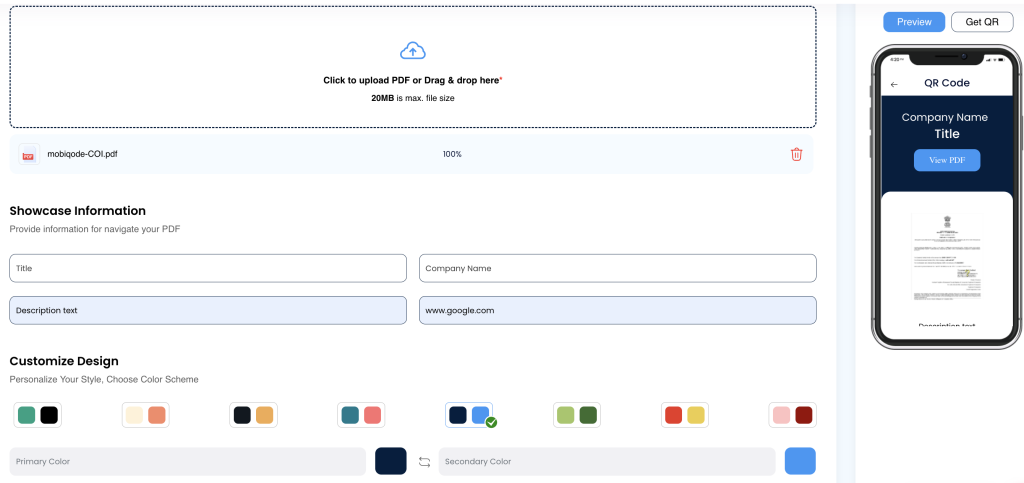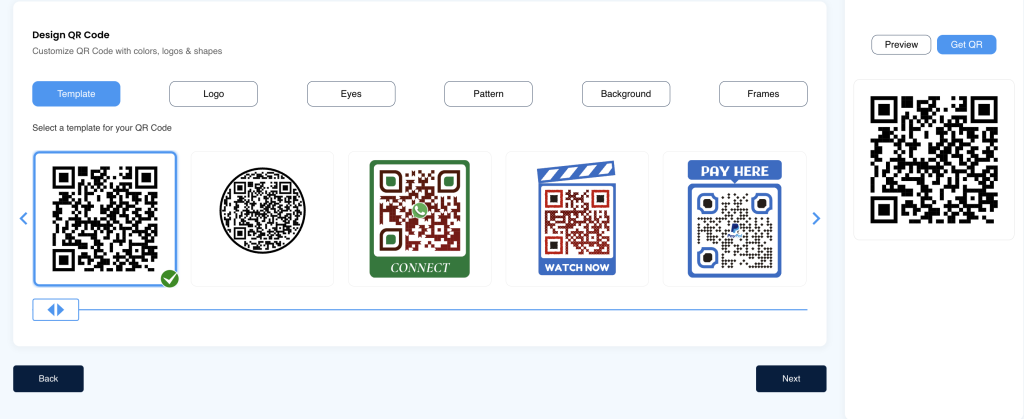How to Create a QR Code for a PDF

Video – How to create a PDF QR Code
Did you know that 82% of businesses have adopted PDF as their primary document storage and sharing format?
Given its popularity for information sharing at organizations, people still struggle to share this file format with clients. That’s probably because:
- Large PDF files can’t be sent via emails
- Long, complex URLs leading to typos when manually entered
- Difficulty accessing files across different devices or platforms
- Version control issues when multiple copies are circulating
- Security concerns when sharing sensitive documents publicly
But if you create a QR code for PDF documents, you’re not just sharing a file but offering a seamless, user-friendly experience.
These compact, scannable codes instantly connect users to your PDF document, streamlining access across devices.
But the question is, what is a PDF QR code?
Let’s find out below.
What is a PDF QR code?
A PDF QR code is a scannable image that instantly directs users to a digital PDF file. Once you scan it using a camera or a QR code reader, the linked document automatically opens, eliminating the need for manual URL entry.
Source: Pinterest
QR codes streamline document access, eliminating manual URL entry and email attachments. PDF QR codes enable instant sharing of reports or presentations, regardless of file size or recipient’s email limitations.
Benefits of QR codes for PDF
Instant access
PDF QR codes supercharge document sharing by providing immediate access with a quick scan. Gone are the days of typing long, complex URLs or sifting through crowded email inboxes to find that crucial file. With a PDF QR code, your document is literally at your fingertips.
Imagine you’re at a conference, and an attendee asks for more information on your company’s latest product. Instead of scrambling to find a business card or brochure, you simply direct them to scan a QR code on your booth’s display. In seconds, they have a comprehensive PDF brochure on their device, ready to review at their leisure.
How to achieve this benefits?
To maximize the benefit of instant access, strategically place QR codes on various physical materials. Print them on business cards, event flyers, product packaging, or billboard advertisements. The key is to make the QR code prominent and pair it with a clear call-to-action, such as “Scan for our full catalog” or “Get the complete report here.”
Reduced email clutter
Email inboxes are often overflowing with attachments, making important documents hard to find and manage. PDF QR codes offer an elegant solution to this digital clutter. By sharing documents via QR codes instead of email attachments, you’re keeping inboxes tidier and bypassing pesky attachment size limits.
This benefit is particularly valuable in professional settings.
Consider a marketing team working on a large campaign. Rather than emailing updated design files back and forth (and quickly hitting inbox quotas), they can use a single QR code linked to the latest version of the campaign PDF. Team members can access the most current information without wading through a sea of emails.
How to achieve this benefit?
Instead of attaching large PDFs to emails, include a QR code in your message body or email signature that links directly to the document like this:
Source: Pinterest
This approach works well for newsletters, reports, or any regularly updated documents. You can even create a standardized email template with a QR code placeholder, making it easy to share different documents consistently.
Version control
One of the most frustrating aspects of document sharing is ensuring everyone has the most up-to-date version.
PDF QR codes solve this problem by maintaining a single, current version of your document that all users can access. This eliminates the confusion and potential errors that arise from multiple outdated copies circulating.
You just have to create a dynamic PDF QR code to ensure that all the changes are updated without generating the code multiple times.
How to achieve this benefit?
The key to effective version control with PDF QR codes is to host your document on a cloud service that allows file replacement without changing the URL. Services like Google Drive, Dropbox, or your website can also work.
When updating the document, simply replace the file on your chosen platform while keeping the same file name and location. The QR code, which points to the URL rather than the file itself, remains valid and will lead users to the updated version.
A word of advice: Consider implementing a version tracking system within the PDF, including a “Last Updated” date on the first page or in the footer. This helps users quickly confirm they’re viewing the most recent information.
4. Enhanced print material
PDF QR codes bridge the gap between physical and digital media, breathing new life into traditional print materials. By integrating QR codes into your printed documents, you create dynamic, interactive experiences that extend beyond the limitations of paper.
Source: Pinterest
Think about a product manual, for instance. While the printed version might cover primary usage, a QR code could link to a PDF with advanced features, troubleshooting guides, or instructional videos. This would save on printing costs and provide a richer, more comprehensive user experience.
How to achieve this benefit?
When designing print materials, plan for QR code integration from the start. Allocate space in your layout for QR codes, and consider how they can best complement the printed content.
Use QR codes to provide value-added content that enhances the print experience for maximum impact. This could include:
- Expanded product information in brochures
- Interactive elements in educational materials
- Digital-only coupons or offers in advertising flyers
- Behind-the-scenes content for event programs
A quick recommendation: Ensure the linked PDFs are mobile-optimized, as most users will access them on smartphones. Use responsive layouts and legible fonts to transition from print to digital seamlessly.
5. Environmental-friendly
Another benefit of using PDF QR codes is their ability to increase environmental awareness. By providing digital access to documents that would otherwise be printed, QR codes help reduce paper waste and the associated environmental impact of producing and disposing of physical documents.
Consider a large corporation that regularly distributes policy updates to thousands of employees. By replacing printed memos with a single QR code linked to a digital PDF, they could save reams of paper and significantly reduce their carbon footprint.
How to achieve this benefit?
To maximize the environmental benefits of PDF QR codes:
- Replace physical handouts at events or meetings with prominently displayed QR codes linking to digital versions
- Use QR codes on product packaging to provide digital manuals, warranty information, or extended product details instead of printed inserts
- Implement a QR code system for internal document sharing in office environments to reduce the need for printed memos or reports
What’s more, you can also share the environmental impact your company made with this change. For example, you might calculate and share the number of trees saved or the reduction in carbon emissions achieved by switching to digital distribution.
6. Cost-effective distribution
PDF QR codes can significantly reduce the costs associated with document distribution. By eliminating or reducing the need for printing and physical shipping, businesses and organizations can realize substantial savings, especially for large-scale document dissemination.
For example, a government agency could cut costs by providing PDF forms and informational booklets via QR codes rather than printing large quantities that may quickly become outdated.
How to achieve this benefit?
To maximize cost savings:
- For large-scale document distribution, create a single QR code and share it through low-cost or free methods like social media, email, or website integration
- Use dynamic QR codes that allow you to change the linked PDF without creating a new code, saving on reprinting costs for physical materials containing the QR code
- Implement a print-on-demand system where users can access digital documents via QR codes and only print when absolutely necessary
Consider conducting a cost analysis to quantify the savings. Compare the expenses of traditional printing and distribution methods with the costs of implementing and maintaining a QR code system. This data can be powerful in justifying the switch to digital distribution, especially in large organizations.
Improved accessibility
PDF QR codes can significantly enhance document accessibility, making information more readily available to users with disabilities or those who may struggle with physical documents or complex navigation.
How to achieve this benefit?
To ensure your PDF QR codes truly improve accessibility:
- Optimize the linked PDF for screen readers. Use proper headings, alt text for images, and ensure the document has a logical reading order
- Provide text alternatives for any non-text content within the PDF
- Ensure the website or platform hosting your PDF is also accessible and adheres to WCAG guidelines
- Consider offering multiple format options through your QR code, such as HTML versions of the content or even audio descriptions for users who prefer listening
Regularly test your system with assistive technologies and gather feedback from users with various accessibility needs to continually improve the experience.
Location-based information
PDF QR codes excel at providing context-specific information based on physical location. This capability allows for highly relevant, targeted content delivery that enhances user experience and engagement.
Imagine a museum using QR codes next to each exhibit.
Source: Pinterest
Visitors could scan to access detailed PDF guides about specific artifacts, complete with high-resolution images and in-depth historical context. In a retail setting, QR codes could link to product manuals or assembly instructions right where customers need them most.
How to achieve this benefit?
To leverage location-based information effectively:
- Strategically place QR codes in specific areas of an office, store, or event space, linking to information relevant to that particular location
- Create different PDFs for different contexts, even if they’re about the same general topic. For example, a train station might have unique PDFs for ticketing information, platform guides, and local area maps
- Consider using beacon technology in conjunction with QR codes to push notifications about available PDFs when users enter specific areas
- Regularly update your location-based PDFs to ensure the information remains current and valuable
Remember: Provide clear instructions or context around the QR codes so users understand what information they’ll gain by scanning.
How to create a PDF QR code?
With these and many other benefits, creating a PDF QR code is crucial to ensure your clients or prospects receive access to vital information for improved decision-making. In case you are wondering how to create one, we’ve got you covered.
Read the steps below to create a PDF QR code from scratch.
Please note: We’ve used Mobiqode sto demonstrate how to create PDF QR code. The steps may differ in different PDF QR code generators.
Step 1: Choose and sign in to a PDF QR code generator
Your first step is to choose a QR code generator that helps you create a code from scratch. With Mobiqode, you get:
- Intuitive interface
- Multiple QR code generation options
- Dynamic QR codes
- Scan analytics
When you sign into your Mobiqode account, you’ll get the option to choose a data type for your QR code. Click on PDF to create a PDF QR code.
Step 2: Upload your PDF file
Once you reach the product’s dashboard, Click on create a QR code button to get started.
You will be taken to a page that asks for the type of QR code you’d like to create.
Click on the PDF QR code to get started.
It will direct you to another page that will request that you upload or add the link to your PDF.

Step 3: Customize the look and feel of your code
Once you upload or add the link to the PDF, you will be directed to customization options.
Here, you can decide the look and feel of your QR code.

You can change the color or add a company logo to the code to customize it as per your brand’s theme.
Step 4: Download and test the code before you take it live
Before finalizing, scan it with your phone to ensure it works correctly.
To test the code, you can get it printed on test materials like:
- vCard
- Brochures
- Manuals
- Digital resumes
And the list can go on. This will help you ensure that you’ve not generated blurry QR codes that are hard to read.
That’s it! Once you’ve tested the code and assessed its scan success rate, it is time you implement it on your marketing materials, documents, or website.
Generate a QR code for your PDF with Mobiqode
QR codes transform PDF sharing into a seamless, efficient process. By embracing this technology, you’ll boost document accessibility, reduce distribution costs, and enhance user experience.
QR codes offer a smart solution to modern document-sharing challenges, whether for business or personal use. Start creating your PDF QR codes today and watch your information flow effortlessly.
To get started, you can give Mobiqode a try. This dynamic QR code generator can create various types of codes in seconds. If you’d like to know more about its features, we suggest you give its 14-day free trial a try.